Hello, I’m Michael Zhang — a seasoned Chinese traveler with years of international travel experience under my belt. In this article, I’ll guide you through one of the most culturally rich landmarks in Suzhou, often referred to as the “Venice of the East” — the Tiger Hill Scenic Area. Through my lens, you’ll see how Tiger Hill is more than just a popular destination in Suzhou; it’s a living museum of history. If you’re looking for a trip that blends culture, heritage, and natural beauty, Tiger Hill is a place you shouldn’t miss.
Summary
Tiger Hill Scenic Area
Tiger Hill, also known as Tiger Hill Scenic Area, is located 3.5 kilometers northwest of Suzhou’s ancient city center. With an elevation of 34.3 meters, it covers a total area of 72.8 hectares, including a 15.97-hectare core scenic zone. The site boasts a long and storied history of over 2,500 years. The hill itself is formed from Jurassic volcanic rock. Historically, it was called “Haiyong Mountain.” During the Eastern Jin Dynasty, ministers Wang Xun and Wang Min built villas beside the famous Sword Pond. Later, the area was turned into a temple — Tiger Hill Temple — built along the mountainside. The architectural style of “a mountain hidden within a temple” remains one of the site’s most unique features.
There’s an old saying: “The back of Tiger Hill surpasses the front,” referring to the tranquil beauty of the hill’s lesser-known rear section, where you’ll find ancient stone bridges, a traditional stone archway, and classic scholar rocks. As one of Suzhou’s most iconic landmarks, Tiger Hill is also officially designated as a 5A National Scenic Area — the highest rating for tourist attractions in China.
- Location: Tiger Hill Scenic Area, Gusu District, Suzhou (Apple Maps / Amap)
- Opening Hours:
- May to October: 7:30 AM – 6:00 PM (Last ticket sold at 5:00 PM; last entry at 5:30 PM); July to August (Summer Holiday): 7:30 AM – 9:00 PM (Last ticket sold at 8:00 PM; last entry at 8:30 PM)
- November to April: 7:30 AM – 5:30 PM (Last ticket sold at 4:30 PM; last entry at 5:00 PM)
- Recommended Duration: 3 to 4 hours
- Best Seasons to Visit: Spring (March–May) and Autumn (September–October)
- Virtual Tour: Click to Explore
- Ticket Prices: 70 CNY (High Season), 60 CNY (Low Season)
- Tickets: Trip.com Discounts
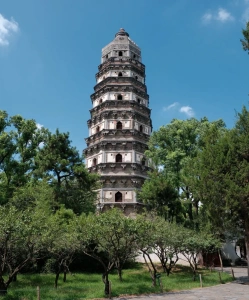
Tiger Hill Map
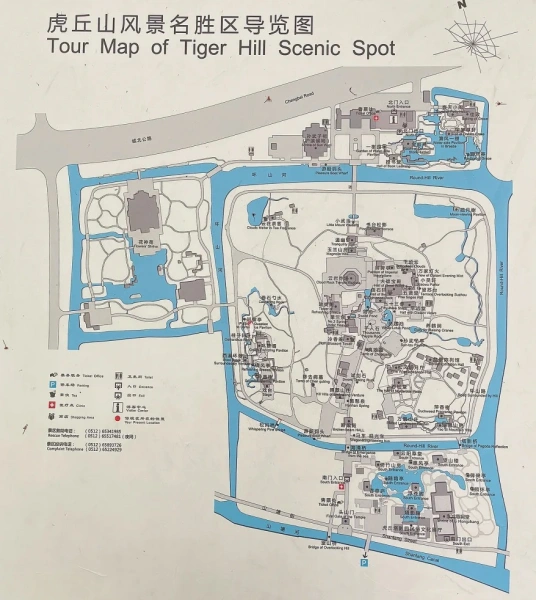
Why You Should Visit Tiger Hill
A Place Rich in Cultural Heritage
The name Tiger Hill originates from the Spring and Autumn Period, when King Helü of Wu was buried here. Legend says that three days after his burial, a white tiger was seen crouching on the hill — hence the name. Throughout the centuries, Tiger Hill has remained a beloved subject among poets and scholars and continues to draw curious travelers from across the globe.
Iconic landmarks such as Tiger Hill Pagoda, Sword Pond, and Thousand-Person Rock each tell a story of the region’s past. Whether you’re a fan of Chinese history or simply enjoy exploring cultural landmarks, Tiger Hill offers an experience steeped in meaning.
Breathtaking Natural Beauty in All Seasons
Tiger Hill isn’t just a historical treasure; it’s also a place of natural beauty. In spring, wildflowers bloom and the landscape bursts into green. In summer, towering trees offer shade as cool breezes flow through the forest. Autumn brings fiery red maples and golden foliage, while winter covers the hill in a pristine white, creating a quiet wonderland.
No matter the season, the scenic trails of Tiger Hill never fail to captivate. Walking along the stone paths beneath centuries-old trees, surrounded by birdsong and the scent of flowers, feels like stepping into a living Chinese painting.
Top Things to Do in Tiger Hill
Main Attractions
Tiger Hill Pagoda (Yunyan Pagoda)
Tiger Hill Pagoda, also known as Yunyan Pagoda, stands as the most iconic structure in the entire Tiger Hill Scenic Area. Often referred to as the “Leaning Tower of the East,” this seven-story, octagonal pagoda built with brick and wood was originally constructed during the Later Zhou Dynasty in 959 AD. Due to uneven geological layers beneath its foundation, the pagoda leans about 3 degrees to the northwest, making it visually striking from a distance.
More than just a marvel of ancient engineering, the pagoda is widely considered a symbol of Wu culture. It represents the intersection of Buddhist traditions and architectural achievements in Suzhou. Whether you’re a history enthusiast or a photography lover, standing beneath this towering monument offers a profound sense of historical gravity and structural tension.
.webp)
Sword Pond
Sword Pond is the most legendary site on Tiger Hill. According to folklore, King Helü of Wu was buried here during the Spring and Autumn Period, alongside 3,000 swords. The water in the pond remains deep and crystal-clear year-round, and many believe its depths conceal the glint of ancient blades. The two cliffs flanking the pond resemble natural gates, adding to its mysterious atmosphere.
This legendary burial site was even mentioned in Sima Qian’s Records of the Grand Historian, which adds further historical weight. Today, Sword Pond is both a poetic destination and a pilgrimage spot for those drawn to ancient mysteries. As you stand beside the pool, it’s easy to imagine the echo of a blade being drawn from its sheath.
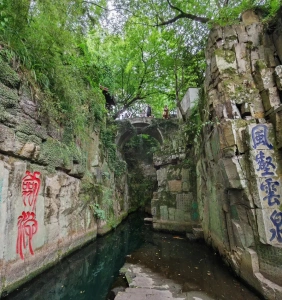
Broken Beam Hall
Broken Beam Hall gets its name from a visibly fractured beam in the main structure. Though the central beam is broken, the building still stands firm — a testament to the brilliance of Ming Dynasty architecture. The hall is filled with the aroma of incense and a solemn, timeless ambiance, echoing the historic tone of the entire Tiger Hill site.
Architecture lovers are especially drawn to this hall. Many gather beneath the broken beam, marveling at how it remains upright, discussing its underlying construction techniques. More than a structural wonder, the hall serves as a metaphor — externally fractured, yet internally stable; cracked in appearance, yet strong at its core.
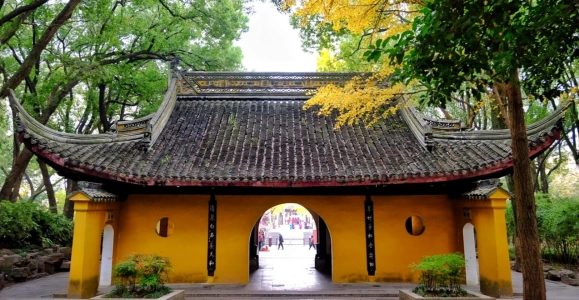
Wanjing Villa
Wanjing Villa, built during the Qing Dynasty, forms a vital part of Tiger Hill’s classical garden landscape. Its design is delicate and harmonious, featuring pavilions, arched bridges, and serene ponds, all laid out in the finest tradition of Jiangnan garden art. The name “Wanjing,” meaning “Ten Thousand Views,” reflects the villa’s purpose — to present endless beauty, changing with each season and turn.
This is where you’ll witness Suzhou’s signature garden aesthetics: borrowing views from nature, emphasizing water and rock as the soul of the garden, and balancing illusion with reality. Whether you’re here for photos or quiet contemplation, Wanjing Villa delivers a journey rich in visual elegance and cultural depth.
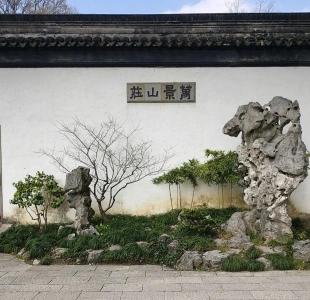
Tiger Hill Ticket Guide
Ticket Prices
- Adults: 70 CNY (high season), 60 CNY (low season)
- Children/Students/Seniors: 35 CNY (high season), 30 CNY (low season)
- Applies to children over 1.4m tall, minors under 18 years old (including 18), university students and below, and seniors aged 60–69
- Free admission: Children under 1.4m (including 1.4m), children aged 6 and below, and seniors aged 70 and above
Where to Buy Tickets
- Online: Official WeChat account (“苏州园林”) or third-party platforms
- Ticket Purchase: Trip.com Discounts
- On-site: Available at ticket windows
Recommended Touring Route for Tiger Hill
Recommended route: Enter from the South Gate, exit via South Gate
- Detailed route: After entering through the South Gate, cross the bridge and continue walking up along the central axis. Highlights along this path include: → Broken Beam Hall → Hanhan Spring → Yongcui Villa → Sword Testing Stone → Tomb of Lady Zhen → Thousand-Person Rock → Third Spring → Su Wu Pavilion → past Sword Pond → and finally arrive at Tiger Hill Pagoda.
- After visiting the pagoda, continue walking further back to find tranquil bamboo groves, a tea garden, and resting areas where you can enjoy a quiet cup of tea.
- Tips:
- Fewer people before 9:00 AM, as tour groups usually arrive around 9:00
- Wear sneakers: there are many stone paths and steps
- Bring mosquito repellent — the greenery attracts a lot of insects
Recommended Local Food Near Tiger Hill
There are not many dining options directly around Tiger Hill. After your visit, you can take a 20-minute boat ride to Shantang Street, where you’ll find a wide variety of restaurants. Locals often head there in the evening to relax and dine. Taking the boat also helps you skip the long entrance queues at Shantang Street.
Xiaohuanxi Subang Cuisine

- Why it’s recommended: Offers truly authentic Suzhou cuisine. Must-try dishes include salt-and-pepper ribs, fried pork chops, spicy stir-fried intestines, and squirrel-shaped mandarin fish.
- Address: No.17 Nanxin Road, Gusu District, Suzhou (Apple Maps / Amap)
- Opening Hours: Monday to Sunday, 10:00–14:00, 16:00–21:00
- Average Cost: 80 CNY per person
Laochangmen Restaurant (Shantang Street Branch)
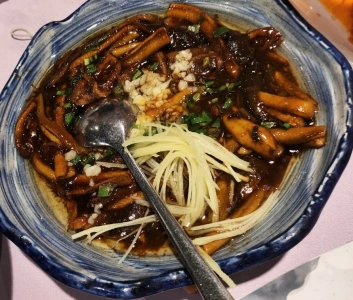
- Why it’s recommended: One of the most well-known restaurants in Suzhou. Recommended dishes include hand-peeled shrimp and Suzhou-style eel in hot oil.
- Address: No.6 North Wharf, Changmen, Gusu District, Suzhou (Apple Maps / Amap)
- Opening Hours: Monday to Sunday, 09:00–21:00
- Average Cost: 111 CNY per person
Recommended Hotels Near Tiger Hill
Tiger Hill is relatively isolated from other tourist attractions, so most visitors stay in the city center and spend half a day exploring the hill. The best area to book accommodation is around Guanqian Street, where you’ll find many popular attractions and plenty of great local restaurants.
Suzhou Liuxiang Hotel (Guanqian Street Pingjiang Road)
.webp)
- Transportation: 5 minutes on foot from Guanqian Street
- Price per night: from 349 CNY
- Check Rates: Trip.com Specials
- Rating: 9.6 on Trip
- Special Amenities: Gym, laundry room, family room
The hotel is just 200 meters from both Pingjiang Road and Guanqian Street — only a few minutes’ walk. It’s also conveniently located near the Suzhou Museum and the Humble Administrator’s Garden.
Rooms are clean and well-maintained. The space feels bright and open as soon as you walk in, making it a highly cost-effective choice.
ARULA Youngor Central Hotel
.webp)
- Transportation: 5 minutes on foot from Guanqian Street
- Price per night: from 398 CNY
- Check Rates: Trip.com Specials
- Rating: 9.6 on Trip
- Special Amenities: Laundry room, robot room service, family room
The hotel enjoys a prime location — just steps away from lively Guanqian Street and not far from Pingjiang Road. Suzhou Park is also nearby. It’s located inside a shopping mall, with Youngor clothing stores on the 1st and 2nd floors. The reception and lounge are on the 3rd floor, where guests are welcomed with a refreshing plum drink. Check-in is on the 3rd floor before heading up to your room.
Rooms are spacious, clean, and equipped with high-end amenities. Floor-to-ceiling windows offer a stunning city skyline view, and the soft, skin-friendly bedding provides a perfect rest after a long day.
Crystal Orange Hotel Suzhou Guanqian Street
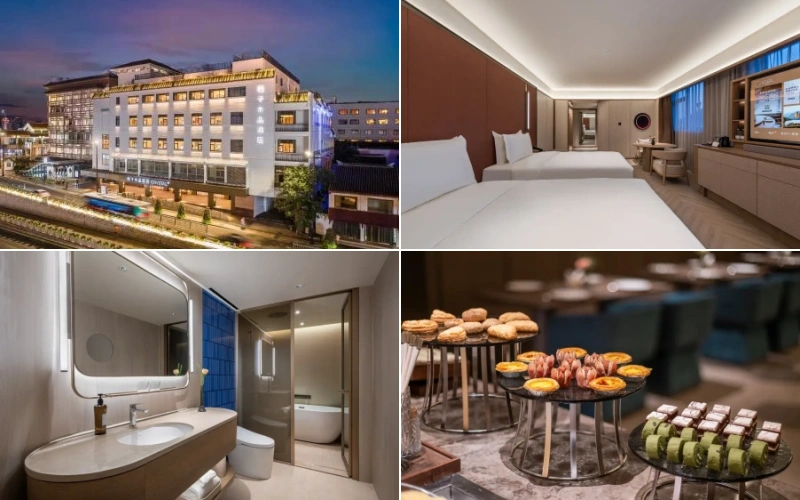
- Transportation: 3 minutes on foot from Exit 6 of Leqiao Metro Station
- Price per night: from 494 CNY
- Check Rates: Trip.com Specials
- Rating: 9.8 on Trip
- Special Amenities: Laundry room, gym, robot room service
This hotel boasts a superb location in the Guanqian Street business district, right next to Pingjiang Road. It’s surrounded by famous eateries such as Gusu Bridge Noodles, Lvyang Wonton, Yaba Shengjian, and Sanwanchang — all within walking distance. Suzhou Museum, the Humble Administrator’s Garden, and the Lion Grove Garden are also nearby. Getting to Shantang Street, Hanshan Temple, or Shiquan Street by taxi is easy and quick.
The rooms are spacious, comfortable, and spotlessly clean. Electric curtains and user-friendly smart devices add to the experience. While the price is on the higher side for Suzhou, it’s well worth it.
How to Get to Tiger Hill from Suzhou City Center
Suzhou’s metro system offers direct access to Tiger Hill. Take Metro Line 6 and get off at Tiger Hill Station. Exit via Exit 3 and walk about five minutes to reach the entrance. Whether you’re coming from Suzhou North Railway Station or Suzhou Railway Station, the metro journey takes around 30 minutes.
How to Get to Tiger Hill from Downtown Shanghai
The most convenient way to get from Shanghai to Tiger Hill is via high-speed rail plus metro. Take a train from Shanghai Railway Station to Suzhou Station (around 30 minutes). Then, transfer to Metro Line 4, get off at Suzhoujin Station, and change to Metro Line 6. Ride to Tiger Hill Station, and from there it’s a 5-minute walk.
- Route: Shanghai → Suzhou
- Train Tickets: Check Times
FAQ
Unfortunately, it’s not. The paths are mostly cobblestone and very uneven, making it extremely difficult to navigate with strollers or wheelchairs.
There is a free luggage storage area called Tiger Hill Station located to the left of the South Entrance. It accepts large suitcases as well. In addition, free lockers are available at the South Entrance ticket office.

 English (Singapore)
English (Singapore)
 English (US)
English (US)  English (Hong Kong)
English (Hong Kong)  English (Malaysia)
English (Malaysia)  繁體中文
繁體中文 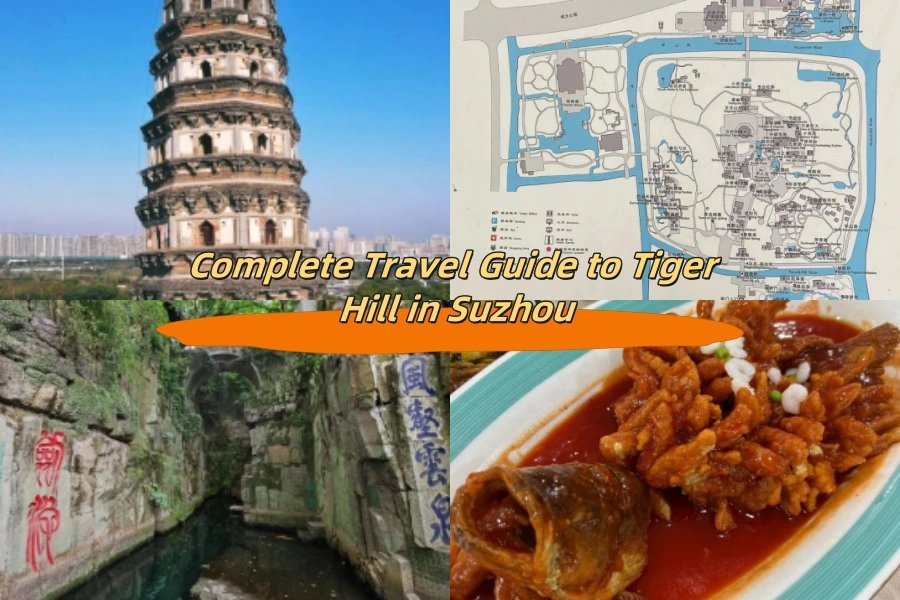
Comment (0)